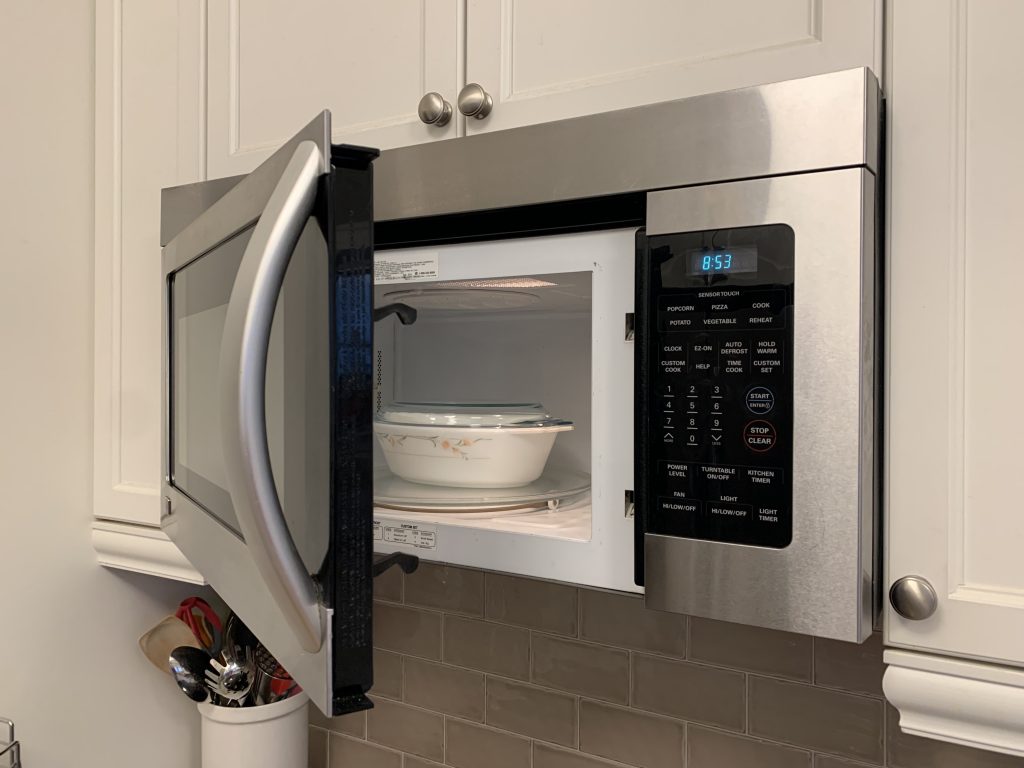Microwave ovens are convenient appliances to have in the kitchen. They are great for thawing and particularly good for cooking vegetables, making cream sauces and soups, and reheating leftovers.
Microwaves can be used for other foods such as cookies, cakes, and meats, but the colour, flavour and texture is not the same as when these foods are cooked in an oven.

Microwaves work by emitting short radio waves that make the water, sugar and fat molecules in food vibrate quickly and heat up to cook the food. Microwaves only penetrate from 1 ½ to 2 inches (4-5 cm) into the food. If the food is thicker than this, the rest of the food is cooked by heat transfer. There is a “standing time” given in most microwave recipes to allow the heat to transfer and thoroughly cook the food.
Getting Started
- Microwave must be set up on a flat surface away from clutter and water. Place it directly on the countertop (do not stack on anything).
- Be sure the vents are clear and not covered by anything.
- Do not place anything on top of the microwave when in use.
- Read all instructions that come with the microwave to understand unique functions and features like kitchen timer, defrost functions, specific food settings.
- Under-cabinet microwaves and built-in microwaves should be installed by a professional to ensure proper venting.
Microwave Oven Safety
- Plug the cord into a three-prong grounded outlet. In some cases a new outlet may be needed if your kitchen has older wiring.
- Never operate a microwave if the door or door seal is damaged.
- Do not turn the microwave on if there is no food inside it. Running a microwave empty will damage your oven.
- Use oven mitts when removing dishes from the microwave as they may be hot.
- Take care when uncovering a dish after cooking. Lift the cover so that the steam escapes away from you to avoid getting burned.
- Only use microwavable-safe dishware in the microwave. The indication can be found on the original dishware tags or on the bottom of the dish. Signage on the bottom will say microwavable or have a microwave-safe symbol:

Microwave Cookware
- Pyrex, Anchor Hocking and Corning Ware dishes are made of heat resistant glass and are microwave-safe.
- Other cookware that is safe for use include glass and porcelain.
- Oven cooking bags provide safe, even cooking with easy clean up.
- Never use metal cookware, metal twist ties or metal trimmed dishes in the microwave.
- Plastic margarine and yogurt containers are not recommended for the microwave.
- Never heat baby bottles or baby food jars in the microwave. They heat unevenly and may burn the baby or even explode.
- Do not microwave food in narrow necked bottles or closed containers. They may crack or potentially explode.
How do I test if a dish is microwave safe? Put the dish in the microwave. Place ½ cup (125ml) of water in an ovenproof glass measuring cup and place it beside (but not touching) the dish to be tested. Microwave on high for 1 minute. The water should be very warm or even hot. If the container being tested is cool or only slightly warm, it is safe to use in the microwave. If it is hot, do not use it in the microwave.
Cleaning Your Microwave
- Wash down the inside of the microwave with a damp soapy cloth. For baked on items, heat up a cup of water in the microwave to boiling and let the steam soften the food to make it easier to clean.
- Wipe up any spills before using your microwave as residue from food can burn and cause damage to the inside of the appliance.
Did you know you can use your microwave to sanitize dish cloths and sponges? When your dishcloths start to smell, it’s due to bacteria. Instead of throwing them out, put your soaked dishcloth or sponge in the microwave for 2 minutes on high to kill the bacteria and get rid of any bad smell.
Microwave Cooking Techniques
Things to Remember:
- Foods cooked in the microwave can reach high temperatures quickly, making it easy to overcook. To avoid this, always start with the shortest time suggested and increase time as necessary to cook/ reheat to safe internal temperatures. For information on safe internal temperatures of cooked foods read Food Safety.
- Larger amounts of food will take more time to properly heat/cook than smaller amounts. For example, cooking one potato takes 5-8 minutes but 2 potatoes will take 10-13 minutes.
- Cover food for faster and more even cooking, and to prevent splatters.
- If there are no microwave-safe lids to cover food, place a damp paper towel over the dish. Other things to use in place of a lid: wax paper, parchment paper, microwave-safe plate and plastic wrap (do not allow plastic wrap to touch food and pull back a small amount to vent).
- To ensure evenly distributed heat, stop the microwave about halfway through cooking/reheating and stir food. Once mixed, replace back in the microwave oven and continue to cook/reheat through until the desired internal temperature is reached.
- Round dishes are better for cooking than square or oblong ones. The food in the corners of square/oblong dishes tends to overcook.
- Certain foods such as soups, oatmeal and sauces need to be heated in a deep container to prevent boiling over.
Cooking Tips:
- When cooking meats like bacon or sausage, place a paper towel on the plate, under the food, and a couple more paper towels on top to absorb fat from the meat as it cooks.
- Never try to cook an entire chicken or turkey in the microwave. Microwaves can only penetrate 1 to 1 ½ inches into food, so cooking smaller pieces of meat is preferable. Where possible, debone large pieces of meat as the bone can stop the meat from cooking right through.
- Tender cuts of meat and fish cook well in the microwave. Cook at medium/medium-high power.
- Potatoes should be arranged in a circle with the larger potatoes on the outside and smaller ones on the inside.
- Pierce the skins of foods cooked whole such as potatoes, squash, or apples. This will allow steam to escape from the food as it cooks and prevent exploding.
- When cooking eggs in the microwave, pierce the yolk and white several times or whisk prior to cooking to prevent exploding. Never try to cook an egg in the shell as it will explode!
Food that are easy to cook in the microwave:
- Scrambled or whole eggs (yolk pierced)
- Porridge/oatmeal
- Fish, chicken and other types of tender meat (microwave cooking bags work well for meats)
- Vegetables: fresh, canned or frozen. Try Maple Carrots and Parsnips
- Layered casseroles and hot dips. Try this Mexican layered bean casserole
- Popcorn
- Smores (layer graham crackers with marshmallows and chocolate, melt in microwave and top with additional graham crackers when removed)
- Apple crumble and other desserts
Converting regular recipes to microwave recipes
If you are wanting to use a conventional recipe as a microwave recipe, there are a few changes to consider. First, because there is little evaporation in a microwave, reduce the amount of liquid in casseroles and stews by almost a half. Next, flavours can be stronger in the microwave, so try using half the amount of spices and herbs the conventional recipe calls for. Lastly, when considering cooking time, start with 1 /4 of the conventional cooking time. If the food is not cooked, gradually add more time. For example, a bean casserole with vegetables might take 30 minutes in a conventional oven, but only requires 10 minutes to fully cook in the microwave.
Thawing Frozen Food in the Microwave
- Always remove frozen food from it’s original packaging before putting in the microwave to thaw. Do not put foam trays with plastic wrap in the microwave as they are not heat stable at high temperatures and changes (melting/warping) due to the heat of the food can cause the release of harmful chemicals.
- Always use the defrost setting – it is a lower power and will better defrost your food. Rotate and turn the foods upside down if possible during defrosting.
- For individual pieces, like porkchops or chicken legs, break them apart when possible and rotate and turn them several times during defrosting.
- When thawing ground meats (like ground beef or ground turkey), scrape off the thawed portion as it softens and return the frozen portion back into the microwave.
- Any meat, poultry, fish or egg dishes must be cooked immediately after defrosting in the microwave because some areas of the frozen food may begin to cook during the defrosting time and any bacteria present would not have been destroyed. Do not hold partially cooked food to use later.
For more information from the Dietitians of Canada, read Food Safety: Microwaves.
Read these articles next:
Healthy Eating Habits
Food Safety






